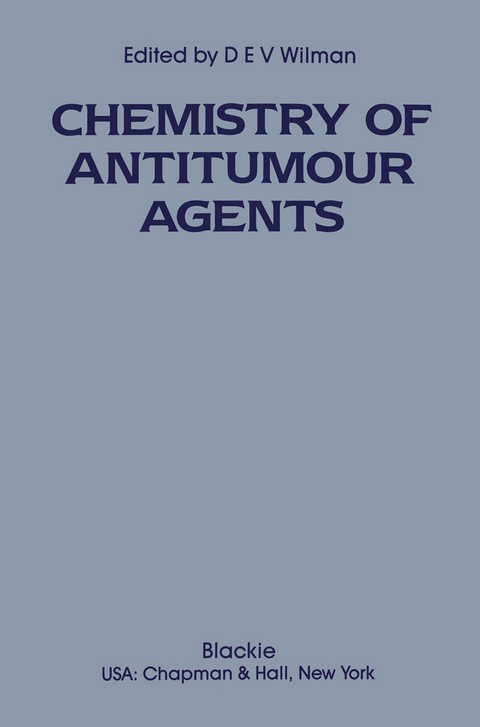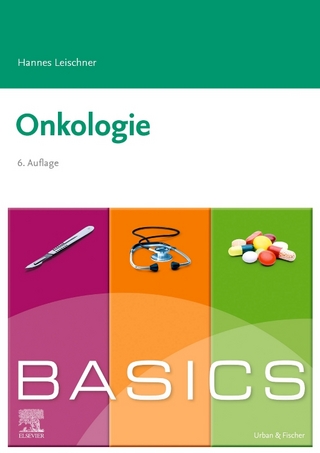
The Chemistry of Antitumour Agents
Kluwer Academic Publishers (Verlag)
978-0-216-92681-3 (ISBN)
- Titel z.Zt. nicht lieferbar
- Versandkostenfrei innerhalb Deutschlands
- Auch auf Rechnung
- Verfügbarkeit in der Filiale vor Ort prüfen
- Artikel merken
1 Acridine-based antitumour agents.- 1.1 Introduction.- 1.2 Nitracrine (NSC 247561) and analogues.- 1.2.1 Synthesis.- 1.2.2 Properties.- 1.3 Amsacrine (NSC 249992) and analogues.- 1.3.1 Synthesis.- 1.3.2 Properties.- 1.4 CI-921 (NSC 343499) and other amsacrine analogues.- 1.4.1 Synthesis.- 1.4.2 Properties.- 1.5 N, N’-Bis-(9-acridinyl)-1,6-hexanediamine (NSC 219733) and related di- and triacridines.- 1.5.1 Synthesis.- 1.5.2 Properties.- 1.5.3 Triacridines.- 1.6 N-[2-(Dimethylamino)ethyl] -9-aminoacridine-4-carboxamide (NSC 342965) and related acridinecarboxamides.- 1.6.1 Synthesis.- 1.6.2 Properties.- 1.7 Conclusions.- References.- 2 Antitumour anthracyclines.- 2.1 Introduction and historical development.- 2.2 Doxorubicin.- 2.2.1 Microbiological isolation.- 2.2.2 Chemical preparation.- 2.2.3 Analytical profile.- 2.3 Epirubicine (4’-epidoxorubicin).- 2.3.1 Preparation.- 2.3.2 Analytical profile.- 2.4 Idarubicine (4-demethoxydaunorubicin).- 2.4.1 Preparation.- 2.4.2 Analytical profile.- 2.5 Spectroscopic properties.- 2.5.1 Infrared spectra.- 2.5.2 Mass spectra.- 2.5.3 Nuclear magnetic resonance spectra.- 2.5.4 Ultraviolet and visible spectra.- 2.5.5 Fluorescence spectra.- 2.5.6 Circular dichroism.- 2.6 Stability and reactivity.- 2.7 Metabolism.- 2.7.1 Synthesis of C-14 14C-labelled derivatives.- 2.7.2 Metabolism in patients.- 2.8 Methods of analysis.- 2.8.1 Spectroscopic analysis.- 2.8.2 Thin-layer chromatography.- 2.8.3 Liquid chromatography.- 2.8.4 Determination of anthracyclines in biological fluids.- 2.9 Aclacinomycin A.- 2.9.1 Microbiological isolation.- 2.9.2 Analytical profile.- 2.9.3 Spectroscopic properties.- 2.9.4 Metabolism.- References and notes.- 3 Alkylating agents.- 3.1 Introduction.- 3.2 Classification of biological alkylating agents.- 3.3 Reactivityof alkylating species.- 3.3.1 The reaction mechanisms of the alkylating agents with water and other nucleophiles.- 3.3.2 The electrophilicity of alkylating agents.- 3.3.3 Formation of DNA adducts.- 3.3.4 Structural modulation of alkylating agent reactivity.- 3.4 Chemical features involved in the transport and uptake of alkylating agents.- 3.4.1 Lipophilicity.- 3.4.2 Molecular structure.- 3.5 Preparative chemistry.- 3.5.1 Sulphur mustards.- 3.5.2 Nitrogen mustards.- 3.5.3 Aziridines.- 3.5.4 Methanesulphonates.- 3.5.5 Oxiranes.- 3.5.6 Benzo- and naphthoquinones.- 3.5.7 Piperazinediones.- 3.5.8 Diazoalkanes.- 3.5.9 ?-Methylene-?-lactones.- 3.5.10 Alkyl halides.- 3.6 The metabolism of alkylating agents.- 3.6.1 Cyclophosphamide and iphosphamide metabolism.- 3.6.2 Metabolism of CB 1954.- 3.7 Quantitative structure-activity relationships of the alkylating agents.- 3.7.1 Optimisation of lipophilicity by QSAR analysis.- 3.7.2 Separation of the structural features responsible for adverse effects from those responsible for activity.- 3.7.3 Structural effects in the carrier molecules.- 3.8 Concluding remarks.- References.- 4 Nitrosoureas.- 4.1 Introduction.- 4.2 Structure-activity relationships.- 4.2.1 Leukaemia L 1210.- 4.2.2 Solid tumours.- 4.3 Toxicity.- 4.4 Chemical basis of biologic activity.- 4.5 Structure and latentiation.- 4.5.1 Enzymic activation.- 4.5.2 Chemical activation.- 4.6 Structure and stability.- 4.7 Structure and metabolism.- 4.8 Water-soluble nitrosoureas and chlorozotocin analogues.- 4.9 Structural modifications and special carrier groups: aspirations.- References.- 5 Triazenes.- 5.1 Introduction.- 5.2 1-Aryl- and 1-heteryl-3, 3-dialkyltriazenes.- 5.2.1 Synthesis and structure.- 5.2.2 Antitumour activity.- 5.2.3 Metabolism.- 5.2.4 Chemistry.- 5.33-Alkyl-1-aryltriazenes.- 5.3.1 Synthesis.- 5.3.2 Structure.- 5.3.3 Chemistry.- 5.3.4 Monoalkyltriazenes as heterocyclic synthons.- 5.3.5 Biochemistry.- 5.4 Hydroxymethyltriazenes.- 5.5 Bis-triazenes: N, N-bis-(1-aryl-3-methyltriazen-3-ylmethyl)methylamines.- 5.6 1,3-Dialkyl- and 1,3,3-trialkyltriazenes.- 5.6.1 Synthesis.- 5.6.2 Reactions.- 5.6.3 Biological activity.- 5.7 Triazene N-oxides.- 5.8 Concluding remarks.- References.- 6 The chemistry of azolotetrazinones.- 6.1 Introduction.- 6.2 Synthesis.- 6.3 Reactions involving opening of the tetrazinone ring.- 6.4 Reactions involving retention of the tetrazinone ring.- 6.5 Relationship of the chemistry of the azolotetrazinones to their biochemistry.- 6.6 Concluding remarks.- References.- 7 Chemistry of antifolates.- 7.1 Introduction.- 7.2 Inhibitors of dihydrofolate reductase (EC 1.5.1.3).- 7.3 Inhibitors of thymidylate synthase (EC 2.1.1.45).- 7.4 Inhibitors of purine biosynthesis.- 7.5 The polyglutamyl metabolites of antifolates.- 7.6 Concluding remarks.- References.- 8 Inhibitors of steroid hormone biosynthesis and action.- 8.1 Introduction.- 8.2 Drugs for the treatment of breast cancer.- 8.2.1 Aminoglutethimide.- 8.2.2 4-Hydroxyandrost-4-ene-3,17-dione.- 8.2.3 Danazol.- 8.2.4 Tamoxifen.- 8.2.5 Medroxyprogesterone acetate.- 8.3 Drugs for the treatment of prostatic cancer.- 8.3.1 Luteinising hormone-releasing hormone agonists.- 8.3.2 Ketoconazole.- 8.3.3 4-Azasteroids as 5?-reductase inhibitors.- 8.3.4 Cyproterone acetate.- 8.3.5 Bifluranol.- 8.3.6 Flutamide.- 8.4 Concluding remarks.- References.- 9 Anticancer pyrimidines, pyrimidine nucleosides and prodrugs.- 9.1 Introduction.- 9.2 5-Fluorouracil and related 5-fluoropyrimidine compounds.- 9.2.1 Synthesis of 5-fluorouracil, nucleosides and derivatives.- 9.2.2 Mode ofaction and catabolism of 5-fluorouracil.- 9.3 1-(?-D-Arabinofuranosyl)cytosine.- 9.3.1 Syntheses of 1-(?-D-arabinofuranosyl)cytosine.- 9.4 5-Azacytidine and related nucleosides.- 9.4.1 Syntheses of 5-azacytidine and analogues.- 9.5 Selected experimental agents.- 9.6 Prodrugs of pyrimidines and pyrimidine nucleosides.- 9.6.1 Prodrugs of 1-(?-D-arabinofuranosyl)cytosine.- 9.6.2 Prodrugs of 5-fluorouracil and 2’-deoxy-5-fluorouridine.- 9.6.3 2,2’-Anhydro-l-(?-D-arabinofuranosyl)-5-fluorocytosine.- 9.7 Conclusions.- References.- 10 Purines and purine nucleoside analogues as antitumour agents.- 10.1 Introduction.- 10.2 Purine analogues.- 10.3 Purine nucleosides.- 10.4 Purine cyclic nucleotides.- 10.5 Certain other nucleosides biochemically related to purines.- 10.5.1 Tiazofurin.- 10.5.3 Pyrazofurin.- 10.5.4 2’-Deoxycoformycin (pentostatin).- References.- 11 Methylmelamines.- 11.1 Introduction.- 11.2 Hexamethylmelamine.- 11.3 Pentamethylmelamine.- 11.4 Trimelamol.- 11.5 Chemistry.- 11.5.1 Synthesis of alkylmelamines.- 11.5.2 Synthesis of N-hydroxymethylmelamines.- 11.5.3 Radiolabeled syntheses.- 11.5.4 Crystal structure.- 11.6 Concluding remarks.- References.- 12 The chemistry of platinum antitumour agents.- 12.1 Introduction.- 12.2 Cisplatin.- 12.2.1 Synthesis and characterisation.- 12.2.2 Reaction chemistry and mechanism of action.- 12.3 Carboplatin.- 12.3.1 Synthesis and characterisation.- 12.3.2 Reaction chemistry and mechanism of action.- 12.4 Iproplatin 336 12.4.1 Synthesis and characterisation.- 12.4.1 Synthesis and characterisation.- 12.4.2 Reaction chemistry and mechanism of action.- 12.5 Compounds containing the 1,2-diaminocyclohexane ligand.- 12.6 Concluding remarks.- References.- 13 Hypoxia-selective agents: radiosensitisers and cytotoxins.- 13.1Introduction.- 13.2 Radiosensitisers.- 13.2.1 Nitroxyl free radicals.- 13.2.2 Electron-affinic radiosensitisers.- 13.3 Hypoxia-mediated cytotoxins.- 13.4 Concluding remarks.- References.- 14 The chemistry and structure-activity relationships of some new prodrugs of vinca alkaloids.- 14.1 Introduction.- 14.2 History.- 14.3 Structure-activity relationships.- 14.4 Chemical modifications.- 14.4.1 Nomenclature and abbreviations.- 14.4.2 C-23 terminal modification.- 14.4.3 C-4 modification.- 14.5 Discussion.- References.- 15 The chemistry of mitomycins.- 15.1 Introduction.- 15.2 Mitomycins and acids.- 15.3 Mitomycins and base.- 15.4 Mitomycin rearrangements.- 15.5 Chemistry at C-7.- 15.6 Mitomycins-metal complexes.- 15.7 Chemistry in the reduced state.- 15.7.1 Bioreductive alkylation as the mode of action of the mitomycins.- 15.7.2 Bioreductive alkylation products with DNA.- References.- 16 The chemistry of activated bleomycin.- 16.1 Introduction.- 16.2 Activation of metallobleomycins.- 16.3 Chemistry of DNA strand scission.- 16.4 Bleomycin-mediated degradation of structurally altered DNA substrates.- References.- 17 Actinomycins.- 17.1 Introduction.- 17.2 Mode of action.- 17.3 Natural structural variations.- 17.4 Biosynthetic analogues.- 17.5 Total synthesis of peptidic analogues.- 17.6 Total synthesis of chromophoric analogues.- 17.7 Partial synthesis of 2-substituted chromophoric analogues.- 17.8 Partial synthesis of 7-substituted chromophoric analogues.- 17.9 Tetracyclic chromophoric analogues.- 17.10 Summary.- References.- 18 Ellipticines.- 18.1 Isolation and structure of the pyrido[4,3-6]carbazole alkaloids.- 18.2 Synthesis.- 18.2.1 Syntheses involving the formation of ring B.- 18.2.2 Syntheses requiring the formation of ring C as the last step information of the tetracycle.- 18.2.3 Syntheses utilising ring D formation as the last step in construction of the tetracycle.- 18.3 Structure-activity studies.- 18.4 Theories of the mode of action.- 18.4.1 Intercalation and the effect on topoisomerases.- 18.4.2 Alkylation of macro-biomolecules.- 18.4.3 Radical and superoxide formation.- 18.5 Clinical applications.- 18.6 Subjective comments.- References.
| Erscheint lt. Verlag | 30.4.1990 |
|---|---|
| Zusatzinfo | 460 p. |
| Verlagsort | Dordrecht |
| Sprache | englisch |
| Themenwelt | Medizin / Pharmazie ► Medizinische Fachgebiete ► Onkologie |
| Naturwissenschaften ► Chemie ► Anorganische Chemie | |
| Naturwissenschaften ► Chemie ► Organische Chemie | |
| ISBN-10 | 0-216-92681-5 / 0216926815 |
| ISBN-13 | 978-0-216-92681-3 / 9780216926813 |
| Zustand | Neuware |
| Haben Sie eine Frage zum Produkt? |
aus dem Bereich


